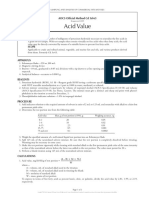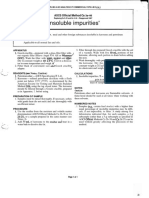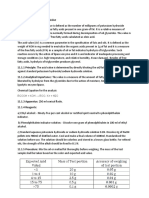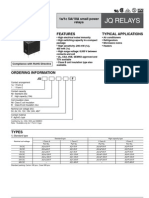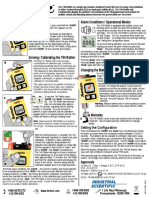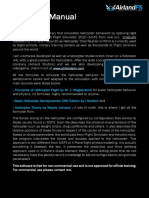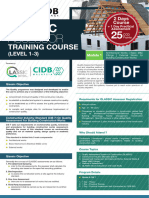Iodine Value
Iodine Value
Uploaded by
Robert GilmoreCopyright:
Available Formats
Iodine Value
Iodine Value
Uploaded by
Robert GilmoreOriginal Description:
Copyright
Available Formats
Share this document
Did you find this document useful?
Is this content inappropriate?
Copyright:
Available Formats
Iodine Value
Iodine Value
Uploaded by
Robert GilmoreCopyright:
Available Formats
INDUSTRIAL OILS AND DERIVATIVES
AOCS Official Method Tg 1-64
Reapproved 2009
Iodine Value, Wijs Method
DEFINITION
The iodine value is a measure of the unsaturation of industrial oils and derivatives and is expressed in terms
of the number of cg of iodine absorbed per g of test sample (% iodine absorbed).
SCOPE
Applicable to normal industrial oils and derivatives, such as natural or synthetic drying oils and their fatty
acids. For a specific class or product, refer to the AOCS method for testing the particular product (see
Notes, 1). Replaces Ka 9-51.
APPARATUS
1. Glass-stoppered bottles or wide mouth Erlenmeyer flask500 mL.
2. Glass-stoppered volumetric flaskconforming to National Institute of Standards & Technology (NIST) tolerances and
accurately calibrated to contain 1000 mL.
3. Pipets5, 20, and 25 mL.
4. Filter paperWhatman no. 41H, or equivalent.
REAGENTS (See Notes)
1. Glacial aceticACS grade. The permanganate test should be applied to be sure that this specification is met.
(a) Permanganate testdilute 2 mL of the acid with 10 mL of distilled water and add 0.1 mL of 0.2 M KMnO4. The pink
color must not be entirely discharged within 2 hr.
2. Potassium iodideACS or AR grade.
3. Chlorine99.8% (see Notes, Caution). Satisfactory commercial grades are available in cylinders, but gas must not be dried
by passing through sulfuric acid (sp. gr. 1.84) before introducing into the iodine solution.
NotePrepared Wijs (see Notes, Caution and 2) solution is available commercially and may be used in place of laboratory-prepared solution.
4. Soluble starchtested for sensitivity. Make a paste with 1 g of starch and a small amount of cold distilled water. Add, while
stirring, 200 mL of boiling water. Place 5 mL of this solution in 100 mL of water and add 0.05 mL of 0.1 M iodine solution.
The deep blue color produced must be discharged by 0.05 mL of 0.1 M sodium thiosulfate.
5. Potassium dichromateACS grade. The potassium dichromate is finely ground and dried to constant weight at about
110C before using.
NoteA standard sample of potassium dichromate with a certificate of analysis may be obtained from the National
Institute of Standards Testing in Washington, D.C. This sample, or equivalent, is strongly recommended for the primary
standard for this method. Treat as directed in the certificate of analysis accompanying the sample.
6. Sodium thiosulfate (Na2S2O35H2O)ACS grade.
7. IodineACS grade.
8. Carbon tetrachlorideACS grade (see Notes, Caution, Recommendations and 5).
9. Wijs solution, AR grade (see Notes, Caution).
SOLUTIONS
1. Potassium iodine solutiondissolve 150 g in distilled water and make up to 1 L.
2. Starch indicator solutionmake a homogeneous paste of 10 g of potato starch in cold distilled water. Add to this 1 L of
boiling distilled water, stir rapidly and cool. Salicylic acid (1.25 g/L) may be added to preserve the indicator. If long storage
is required, the solution must be kept in a refrigerator at 410C (4050F). Fresh indicator must be prepared when the end
point of the titration from blue to colorless fails to be sharp. If stored under refrigeration, the starch solution should be stable
for about 23 wk.
3. Sodium thiosulfate solution, 0.1 Mdissolve 24.9 g of sodium thiosulfate in distilled water and dilute to 1 L.
(a) Standardizationweigh 0.160.22 g of finely ground and dried potassium dichromate into a 500 mL flask or bottle
by difference from a weighing bottle. Dissolve in 25 mL of water, add 5 mL of hydrochloric acid, 20 mL of potassium
iodine solution and rotate to mix. Allow to stand for 5 min and then add 100 mL of distilled water. Titrate with sodium
thiosulfate solution, shaking continuously until yellow color has almost disappeared. Add 12 mL of starch indicator
and continue the titration, adding the thiosulfate solution slowly until the blue color has just disappeared. The strength
of the sodium thiosulfate solution is expressed in terms of its molarity.
Molarity of Na2S2O3 solution =
20.394 mass of K 2 Cr2 O7 , g
volume, mL of sodium thiosulfate solution
Page 1 of 4
INDUSTRIAL OILS AND DERIVATIVES
Tg 1-64 Iodine Value, Wijs Method
4. Wijs solution (see Notes, Caution) can be purchased (see Reagents) or prepared in the laboratory. Dissolve 13.0 g of iodine
in 1 L glacial acetic acid. Gentle heating may be necessary to promote solution. Cool remove a small quantity (100200
mL) and set aside in a cool place for future use. Pass dry chlorine gas into the iodine solution until the original titration is
not quite double. A characteristic color change takes place in the Wijs solution when the desired amount of chlorine has
been added. This may be used to assist in judging the end point. A convenient procedure is to add a small excess of chlorine
and immediately bring back to the desired titration by addition of some of the original iodine solution which was taken out
at the beginning. The original solution and finished Wijs solution are both titrated with Na2S2O3 solution as directed in
Procedure, 6 and 7. The Wijs solution may be prepared from commercial iodine monochloride as follows:
(a) Stock SolutionAdd 317 0.1 g of iodine monochloride to 1 L of glacial acetic acid and filter through Whatman no.
41H filter paper or equivalent into a clean and dry actinic glass bottle. Filter rapidly to prevent contamination with
moisture and store in a cool place. Discard the solution if a precipitate forms on standing.
(b) Wijs SolutionUsing a graduated cylinder pour 117.0 0.1 mL of the stock solution into a standard 5 lb bottle of
glacial acetic acid and mix well by shaking.
5. The I/Cl ratio of the Wijs solution shall be within the limits of 1.10 0.1. The procedure for determining the ratio is as
follows:
(a) Iodine content
(1) Pour 150 mL of saturated chlorine water into a 500 mL Erlenmeyer flask and add a few glass beads.
(2) Pipet 5 mL of the Wijs solution into the flask containing the saturated chlorine water. Shake, and heat to boiling.
(3) Boil briskly for 10 min, cool and add 30 mL of 2% sulfuric acid and 15 mL of 15% potassium iodide solution.
(4) Mix well, and titrate immediately with 0.1 M sodium thiosulfate solution to a starch end point.
(b) Total halogen content
(1) Pour 150 mL of recently boiled distilled water into a clean, dry 500 mL Erlenmeyer flask.
(2) Add 15 mL of 15% potassium iodine solution.
(3) Pipet 20 mL of Wijs solution into the flask, and mix well.
(4) Titrate with 0.1 M sodium thiosulfate solution to a starch end point.
CALCULATIONS
Halogen Ratio R =
2A
3B 2A
Where
A = volume of titrant, mL, of iodine content as mL sodium thiosulfate
B = volume of titrant, mL, of total halogen content as mL sodium thiosulfate
PROCEDURE
1. Melt the test sample, if it is not already liquid, and filter through filter paper to remove any solid impurities and the last traces
of moisture. The temperature during melting and filtering should not exceed the melting point of the test sample by more
than 10C. The test sample must be absolutely dry.
Note-All glassware must be absolutely clean and dry.
2. Weigh the test sample (see Notes, 3) accurately into a 500 mL flask or bottle to which has been added 20 mL of carbon
tetrachloride (see Notes, Caution) or other solvent (see Notes, Recommendations and 5). The weight of the test sample must
be such that there will be an excess of Wijs solution of 100150% over the amount absorbed. Table 1 is a guide to the size
of test sample to weight.
3. Pipet the 25 mL of Wijs solution into flask containing the test sample, stopper the flask, and swirl to ensure an intimate
mixture.
4. Prepare and conduct at least two blank determinations with each group of test samples simultaneously and similar in all
respects to the test samples.
5. Store the flasks in a dark place for 30 min at a temperature of 25 5C. For conjugated oils such as tung, oiticica or dehydrated castor oil, allow the absorption to proceed for 1 hr at 25 1C.
6. Remove the flasks from storage and add 20 mL of KI solution, followed by 100 mL of distilled water.
7. Titrate with 0.1 M Na2S2O3 solution, adding it gradually and with constant and vigorous shaking (see Notes, 4). Continue
the titration until the yellow color has almost disappeared. Add 12 mL of starch indicator solution and continue the titration until the blue color has just disappeared.
Page 2 of 4
INDUSTRIAL OILS AND DERIVATIVES
Tg 1-64 Iodine Value, Wijs Method
CALCULATION
Iodine Value =
(B S) M 12.69
mass of test portion, g
Where
B = volume of titrant, mL of blank
S = volume of titrant, mL of test portion
M = molarity of Na2S2O3 solution
NOTES
Caution
Carbon tetrachloride is a known carcinogen. It is toxic by ingestion, inhalation and skin absorption. It is a narcotic. It should not
be used to extinguish fires. It decomposes to phosgene gas at high temperature. The TLV is 5 ppm in air. A fume hood should be
used at all times when using carbon tetrachloride.
Chlorine is a poisonous gas. The TLV is 1 ppm in air. It is a strong oxidizing agent and should not be allowed to come in
contact with organic materials, hydrogen, powdered metals and reducing agents. A fume hood should be used at all times when
using chlorine.
Wijs solution causes severe burns and vapors can cause lung and eye damage. Use of a fume hood is recommended. Wijs
solution without carbon tetrachloride is available commercially.
Potassium dichromate is toxic by ingestion and inhalation. There is sufficient evidence in humans for the carcinogenicity of
chromium [+6], in particular lung cancer. It is a strong oxidizing agent and a dangerous fire risk in contact with organic chemicals.
RECOMMENDATIONS
Cyclohexane has been proposed as a replacement for carbon tetrachloride in the iodine value methodsee AOCS Recommended
Practice Cd 1-87 (89), AOCS Official Method Cd 1d-92 and JAOCS 65:745 (1988). Isooctane has been reported to be a suitable
replacement for chloroform in the peroxide value method, and therefore could be tried as a substitute for carbon tetrachloride in
the iodine value method. These recommendations do not represent official approval by the AOCS Uniform Methods Committee.
Laboratories that use these solvents may report their findings to the AOCS Technical Director.
NUMBERED NOTES
1. When the iodine value is determined on materials having conjugated systems, the result is not a measure of total unsaturation, but rather is an empirical value indicative of the amount of unsaturation present. Reproducible results are obtained
which afford a comparison of total unsaturation. When the iodine value is required on the fatty acids of natural and synthetic
drying oils, the preparation and separation are performed as directed in AOCS Official Method Cd 6-38.
2. All Wijs solutions are sensitive to temperature, moisture and light. Store in a cool and dark place and never allow to come to
a temperature above 25-30C.
3. In the case of dehydrated castor oils, weigh 0.110.13 g.
4. Mechanical stirring is satisfactory for agitating during the addition of thiosulfate.
5. 1,1,1-Trichloroethane (TCE) has been suggested as a replacement for chloroform in this method. Although TCE is a halogenated hydrocarbon, the TLV (350 ppm) is less than those of chloroform, carbon tetrachloride, and methylene chloride.
Cyclohexane and cyclohexaneacetic acid may also be considered as alternate solvents. See AOCS Methods Cd 1b-87 and Cd
1d-92.
Page 3 of 4
INDUSTRIAL OILS AND DERIVATIVES
Tg 1-64 Iodine Value, Wijs Method
Table 1
Test portion mass, g
Iodine
Value
< 3
3
5
10
20
40
60
80
90
100
110
120
130
140
150
160
170
180
190
200
210
220
Page 4 of 4
Normal oils
100150% excess
of reagent
10
10
8.461310.576
5.07706.3460
2.53843.1730
0.84611.5865
0.63460.7935
0.43210.5288
0.31750.3969
0.28220.3528
0.25400.3175
0.23090.2886
0.21170.2646
0.19540.2442
0.18140.2268
0.16930.2116
0.15870.1984
0.14940.1868
0.14110.1764
0.13370.1671
0.12700.1587
0.12100.1547
0.11550.1443
Conjugated oils
115135% excess
of reagent
0.33770.3691
0.30020.3281
0.27020.2953
0.24560.2684
0.22520.2461
0.20780.2271
0.19300.2109
0.18010.1969
0.16890.1846
0.15890.1737
0.15010.1640
0.14220.1554
0.13510.1476
0.12870.1406
0.12280.1374
You might also like
- AOCS Ca 5a-40Document2 pagesAOCS Ca 5a-40Bimmo Dwi Hartono94% (18)
- AOCS CD 8 53 Peroxido Con CL PDFDocument2 pagesAOCS CD 8 53 Peroxido Con CL PDFIvone Sulistya93% (15)
- AOCS Official Method Ce 2-66Document2 pagesAOCS Official Method Ce 2-66Salvador Gomez100% (3)
- AOCS-Method Free Fatty AcidDocument2 pagesAOCS-Method Free Fatty AcidAnonymous BcT42WLn100% (8)
- 442ch1 24-36-02 R00Document94 pages442ch1 24-36-02 R00Muhammad Syukur100% (1)
- AOCS CD 1b-87Document3 pagesAOCS CD 1b-87Luigi Avicenna100% (4)
- 41.1.18 AOAC Official Method 920.160 Saponification Number (Koettstorfer Number) of Oils and FatsDocument1 page41.1.18 AOAC Official Method 920.160 Saponification Number (Koettstorfer Number) of Oils and FatsEmiliano García50% (2)
- Listado de Normas AocsDocument10 pagesListado de Normas AocsJosé Nemo Di Natale0% (1)
- IUPAC 2.201 Determination of The Acid Value and The AcidityDocument4 pagesIUPAC 2.201 Determination of The Acid Value and The Acidity蕭維廷0% (1)
- AOCS CD 1-25 Iodine Value of Fats and Oils - Wijs MethodDocument4 pagesAOCS CD 1-25 Iodine Value of Fats and Oils - Wijs Methodedshe80% (5)
- Color of Fats and Oil, Lovibond (ISO Method) : Through GlassDocument4 pagesColor of Fats and Oil, Lovibond (ISO Method) : Through Glasswil100% (2)
- Iodine Value AOAC Official Method 993.20Document2 pagesIodine Value AOAC Official Method 993.20Guillaume merlaud100% (1)
- AOCS-Cc-3-25-2009 Melting Point PDFDocument2 pagesAOCS-Cc-3-25-2009 Melting Point PDFdwi anggraeni100% (5)
- Refrigeration Cycle Demonstration UnitDocument76 pagesRefrigeration Cycle Demonstration UnitRobert Gilmore100% (1)
- AOCS Official Method Ca 3d Sedimentos en AceiteDocument4 pagesAOCS Official Method Ca 3d Sedimentos en AceiteCarla Sánchez GallardoNo ratings yet
- Aoac 2015.01 Hms in Food by Icp MsDocument8 pagesAoac 2015.01 Hms in Food by Icp MsJOSEPH OMONDINo ratings yet
- Aoac 940.28Document1 pageAoac 940.28laboratorio fisicoquimicoNo ratings yet
- Iodine Value of Fats and Oils Cyclohexane-Acetic Acid MethodDocument3 pagesIodine Value of Fats and Oils Cyclohexane-Acetic Acid MethodNovianto Nugroho100% (2)
- 45.4.10 AOAC Official Method 994.10 Cholesterol in Foods: C) D) E) F) G) H)Document11 pages45.4.10 AOAC Official Method 994.10 Cholesterol in Foods: C) D) E) F) G) H)Angélica VargasNo ratings yet
- AOCS - CD - 3d - 63 Acid ValueDocument3 pagesAOCS - CD - 3d - 63 Acid Valueshirley martinez padilla100% (5)
- Iodine Value Aocs CD 1d-92Document3 pagesIodine Value Aocs CD 1d-92Wynona Basilio83% (6)
- AOCS - CD - 8-53 Peroxido Con CLDocument2 pagesAOCS - CD - 8-53 Peroxido Con CLmanuelsnic83% (6)
- AOCS CD 1b 87 IV PDFDocument4 pagesAOCS CD 1b 87 IV PDFzarlyNo ratings yet
- AOCS Method PDFDocument3 pagesAOCS Method PDFZeref SaintNo ratings yet
- AOCs Appendix PDFDocument10 pagesAOCs Appendix PDFwil100% (1)
- AOCS-Da2a - 48 Moisture and Volatile Matter in Soap and Soap Products, Air Oven Method PDFDocument3 pagesAOCS-Da2a - 48 Moisture and Volatile Matter in Soap and Soap Products, Air Oven Method PDFwilNo ratings yet
- Saponifcation ValueDocument2 pagesSaponifcation ValueRobert Gilmore100% (2)
- AOCS - Da4a-48 Free Acid or Free Alkali in Soda SoapDocument4 pagesAOCS - Da4a-48 Free Acid or Free Alkali in Soda Soapwil100% (1)
- AOCs CD 1d-92Document3 pagesAOCs CD 1d-92dwi anggraeni100% (1)
- AOCS Official Method Ca 2c-25, Moisture and Volatile Matter, Air Oven Method, Reappoved 1997Document1 pageAOCS Official Method Ca 2c-25, Moisture and Volatile Matter, Air Oven Method, Reappoved 1997laboratorium pc08100% (4)
- Pepsi Mix Max Mox ExperimentDocument2 pagesPepsi Mix Max Mox Experimentanon_192325873No ratings yet
- Analytical-Methods-1998 - FAT & OIL HANDBOOKDocument6 pagesAnalytical-Methods-1998 - FAT & OIL HANDBOOKLuki Wahyuning TiyasNo ratings yet
- Peroxide ValueDocument7 pagesPeroxide ValueMahnoor Akbar100% (1)
- Methods Determination of Dobi of CpoDocument4 pagesMethods Determination of Dobi of CpoUun Khairunnisah Koto100% (2)
- Saponifcation ValueDocument2 pagesSaponifcation ValueRobert Gilmore100% (2)
- Free AutoCAD Tutorials - Introduction To AutoCAD 2010 2012 2013Document4 pagesFree AutoCAD Tutorials - Introduction To AutoCAD 2010 2012 2013mohitNo ratings yet
- CH 111 Lab 2Document7 pagesCH 111 Lab 2Usama AsadNo ratings yet
- Peroxide ValueDocument6 pagesPeroxide ValueKrishna KalsekarNo ratings yet
- AOCS Recommended Practice Ca 12-55 Phosphorus PDFDocument2 pagesAOCS Recommended Practice Ca 12-55 Phosphorus PDFWynona Basilio100% (1)
- AOCS CA 12-55 PhosphorusDocument2 pagesAOCS CA 12-55 PhosphorusLuki Wahyuning TiyasNo ratings yet
- IODINE NUMBER (Wijs Method)Document4 pagesIODINE NUMBER (Wijs Method)Visarika Vaidya100% (1)
- Aocs Method CD 1d-92 Índice Iodo (Ciclohexano-Acido Acético)Document3 pagesAocs Method CD 1d-92 Índice Iodo (Ciclohexano-Acido Acético)JulianaNo ratings yet
- AOCS Acid ValueDocument1 pageAOCS Acid ValueAnonymous BcT42WLnNo ratings yet
- AOCS Official Method Ba 5a-49 PDFDocument1 pageAOCS Official Method Ba 5a-49 PDFAmmar Marzuki0% (1)
- Ca 5a 40 FfaDocument3 pagesCa 5a 40 FfaLamya SlassiNo ratings yet
- Acid ValueDocument3 pagesAcid ValueAli Jazie100% (1)
- AOCS CC 3-25-2009 Melting PointDocument2 pagesAOCS CC 3-25-2009 Melting Pointdwi anggraeniNo ratings yet
- Iodine Value Determination Porim Test MethodDocument2 pagesIodine Value Determination Porim Test MethodAdawiyah Ali100% (1)
- AOCS Te 1a-64 - Acid Value (2017) PDFDocument2 pagesAOCS Te 1a-64 - Acid Value (2017) PDFWilson67% (3)
- AOCS Official Method Ca 2b-38Document1 pageAOCS Official Method Ca 2b-38Achintya Samanta100% (2)
- AOCS CA 3a 46 Impureza InsolublesDocument1 pageAOCS CA 3a 46 Impureza InsolublesAntoni Pepe100% (1)
- AOC 92.159 Iodine Absorption NumberDocument1 pageAOC 92.159 Iodine Absorption NumberJuan Felipe Romero RojasNo ratings yet
- ISO 63212002 (E) Slip Melting PointDocument11 pagesISO 63212002 (E) Slip Melting PointLam Lai YanNo ratings yet
- Chlorophyll and Carotenoid Determination 2010Document2 pagesChlorophyll and Carotenoid Determination 2010Shahrukh Ghulam Nabi100% (1)
- AOCS 2d-25-2017Document2 pagesAOCS 2d-25-2017María Renee Quintanilla Vidal100% (1)
- Peroxide Value DeterminationDocument5 pagesPeroxide Value DeterminationJohn Paul Pasicaran75% (20)
- Rancidity of Edible OilDocument2 pagesRancidity of Edible OilUsman Ghani0% (1)
- E222 Hydroxyl Value PDFDocument7 pagesE222 Hydroxyl Value PDFswapon kumar shill100% (2)
- Moisture Volatile OilDocument2 pagesMoisture Volatile OilRobert GilmoreNo ratings yet
- AOAC 936 16 Hidroxido de Sodio PDFDocument1 pageAOAC 936 16 Hidroxido de Sodio PDFAdufe RufaiNo ratings yet
- Moisture - AOCS Palm OilDocument1 pageMoisture - AOCS Palm OilHaza TaufanoNo ratings yet
- Aocs Color MethodDocument4 pagesAocs Color MethodAngga YesNo ratings yet
- Evaluation of Pungency of Different Brands of Mustard OilDocument2 pagesEvaluation of Pungency of Different Brands of Mustard Oilimtiaz_masud_1No ratings yet
- AOCS Official Method Ca 14Document7 pagesAOCS Official Method Ca 14Gerson JuniorNo ratings yet
- Determination of Ethanol Concentration in Aqueous SolutionsDocument3 pagesDetermination of Ethanol Concentration in Aqueous SolutionsShashank Garg100% (1)
- 1 s2.0 S1876610215000648 MainDocument8 pages1 s2.0 S1876610215000648 MainRobert GilmoreNo ratings yet
- SOLTEQDocument4 pagesSOLTEQRobert GilmoreNo ratings yet
- The Concept of Social CohesionDocument19 pagesThe Concept of Social CohesionRobert GilmoreNo ratings yet
- 3027 9108 1 PB OPtimization RSMDocument9 pages3027 9108 1 PB OPtimization RSMRobert GilmoreNo ratings yet
- Resins and Additives For Powder Coatings and Alkyd Paints, Based On Renewable ResourcesDocument10 pagesResins and Additives For Powder Coatings and Alkyd Paints, Based On Renewable ResourcesRobert GilmoreNo ratings yet
- Ch2-Distillation (Part 2) UpdatedDocument29 pagesCh2-Distillation (Part 2) UpdatedRobert GilmoreNo ratings yet
- Moisture Volatile OilDocument2 pagesMoisture Volatile OilRobert GilmoreNo ratings yet
- Resins and Additives For Powder Coatings and Alkyd Paints, Based On Renewable ResourcesDocument10 pagesResins and Additives For Powder Coatings and Alkyd Paints, Based On Renewable ResourcesRobert GilmoreNo ratings yet
- Experiment 1 - Control ValveDocument13 pagesExperiment 1 - Control ValveRobert Gilmore100% (3)
- Experiment 4 - Level Measurement & CalibrationDocument12 pagesExperiment 4 - Level Measurement & CalibrationRobert GilmoreNo ratings yet
- What's The Difference Between Biodiesel and Renewable (Green) DieselDocument14 pagesWhat's The Difference Between Biodiesel and Renewable (Green) DieselRobert GilmoreNo ratings yet
- Experiment No: 4 (Reaction Turbine) : CLB 2O703: Chemical Engineering Thermodynamics Exp. 4: Reaction Turbine 1Document8 pagesExperiment No: 4 (Reaction Turbine) : CLB 2O703: Chemical Engineering Thermodynamics Exp. 4: Reaction Turbine 1Robert GilmoreNo ratings yet
- Bioresource Technology: Junhua Zhang, Lifeng JiangDocument4 pagesBioresource Technology: Junhua Zhang, Lifeng JiangRobert GilmoreNo ratings yet
- Student Guide: Oil and Fat Process TechnologyDocument7 pagesStudent Guide: Oil and Fat Process TechnologyRobert GilmoreNo ratings yet
- Resins and Additives For Powder Coatings and Alkyd Paints, Based On Renewable ResourcesDocument10 pagesResins and Additives For Powder Coatings and Alkyd Paints, Based On Renewable ResourcesRobert GilmoreNo ratings yet
- Guardian Motorcycle 10W40Document1 pageGuardian Motorcycle 10W40Robert GilmoreNo ratings yet
- IV YR - CumulativeDocument8 pagesIV YR - CumulativeKAMESWARARAO DOMMETINo ratings yet
- VRV Iv-FxvqDocument52 pagesVRV Iv-Fxvqcyclon2010100% (1)
- Honda 1Document80 pagesHonda 1KumarNo ratings yet
- CD WorksDocument35 pagesCD WorksThulasidharan Nair Bhaskaran100% (2)
- Manual Kannad 406 AP PDFDocument60 pagesManual Kannad 406 AP PDFGinanjar PranathaNo ratings yet
- Solid State / Crystalline State ChemistryDocument26 pagesSolid State / Crystalline State ChemistrymyiitchemistryNo ratings yet
- TC Kta-50Document69 pagesTC Kta-50jengandxb100% (1)
- Mt2dinvmatlaba Program in Matlab and Fortran For Two Dimensional MagnetotelluricDocument13 pagesMt2dinvmatlaba Program in Matlab and Fortran For Two Dimensional MagnetotelluricAbraham Raymundo Rebollo TapiaNo ratings yet
- Fabrication of High-K Dielectric Calcium Copper Titanate (CCTO) Target by Solid State RouteDocument5 pagesFabrication of High-K Dielectric Calcium Copper Titanate (CCTO) Target by Solid State RouteArindam SenNo ratings yet
- Relè PanasonicDocument6 pagesRelè PanasonicsdfjksdhfkljsNo ratings yet
- Adobe Flex 3.0:: Developing Rich Client ApplicationsDocument5 pagesAdobe Flex 3.0:: Developing Rich Client ApplicationsDiego RangelNo ratings yet
- Control ValveDocument135 pagesControl Valvejnmanivannan100% (1)
- T40 RattlerDocument3 pagesT40 RattlerDeo MananganNo ratings yet
- TeXstudio - User ManualDocument29 pagesTeXstudio - User ManualMariella MateoNo ratings yet
- Hard Question For InstrumentDocument3 pagesHard Question For InstrumentumeshNo ratings yet
- Solution of Exercise 1: FY8201 / TFY8 Nanoparticle and Polymer Physics IDocument3 pagesSolution of Exercise 1: FY8201 / TFY8 Nanoparticle and Polymer Physics ISerpil YilmazNo ratings yet
- Schematic - Fonte Estabilizada 13.8V Alta Corrente 230 Amperes + PCI - 2020-06!09!21!37!01Document1 pageSchematic - Fonte Estabilizada 13.8V Alta Corrente 230 Amperes + PCI - 2020-06!09!21!37!01JosmarNo ratings yet
- Manual Motor Starter & ProtectorDocument6 pagesManual Motor Starter & Protectorgeorgel1980No ratings yet
- Broadband AntennasDocument2 pagesBroadband AntennasJuan Guillermo Palacio UribeNo ratings yet
- MCQ 50 QSDocument14 pagesMCQ 50 QSSumeet VermaNo ratings yet
- AirlandFS Manual 1.3Document29 pagesAirlandFS Manual 1.3FreddimeyerNo ratings yet
- G6B Fetal Monitor SpecifikacijaDocument3 pagesG6B Fetal Monitor SpecifikacijaMedis MEDISNo ratings yet
- Brochure Assessor Training Course Qlassic Academy 2024-1-2Document2 pagesBrochure Assessor Training Course Qlassic Academy 2024-1-2haqproventuresNo ratings yet
- Screw Conveyor Design Calculation - An Engineering GuideDocument8 pagesScrew Conveyor Design Calculation - An Engineering GuideTharanga Kumara PriyadarshanaNo ratings yet
- Session Plan: Upon Completion of This Module The Trainee Must Be Able ToDocument4 pagesSession Plan: Upon Completion of This Module The Trainee Must Be Able ToLeonardNo ratings yet
- 15 Gravity Sewer SpreadsheetDocument3 pages15 Gravity Sewer SpreadsheetShashank YadavNo ratings yet



















